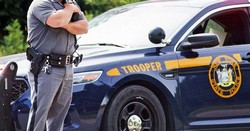The Guardians Club hosted a virtual webinar with Kemar Francis, a New York State Trooper, about the history of the organization and the requirements to become a trooper on Wednesday, Mar. 24.
Francis began the informational session with a brief history of the New York State Police. The organization began in 1917, Francis explained, but its roots date back to an incident a few years prior.
Sam Howell was a construction foreman who was murdered in an armed robbery. He was overseeing the rural estate of Moyca Newell in Bedford, Westchester County. Newell was outraged at the criminals’ ease of escape due to low police presence in their rural area, and with the help of Katherine Mayo, began campaigning to establish a state force that would provide protection to rural areas of New York.
“In honor of these two women, the first academy was called Camp Newayo, a combination of both their names,” Francis explained. “On June 20, 1917, the first troopers began training. 232 men rode out on horseback after the academy was completed. At that time, troopers only rode on horsebacks in groups of 2, traveling about 25 miles per day. Most of the time, you would never see the same troopers back to back. That was done purposely to portray the agency being actually larger than it was.”
Each pair of troopers would travel into different communities and areas, stopping at the local post office to receive reports, Francis said. While in that community, they would answer whatever police investigations would be ongoing at the time.
New York State Trooper uniforms are grey, meant to symbolize an impartial trooper, Francis explained. The purple on the uniform is a reflection of the roman praetorian guard, symbolizing royalty.
“The New York State Police doesn’t wear our actual badges on our uniform,” Francis explained. “We wear a collar ornament and that denotes what area and what troop that we work [within], and the black stripe on the side of our uniform pants is in honor of our fallen members.”
People oftentimes associate troopers solely with highway patrol but there’s more to the job than that, Francis said. “We also provide officer presence at largely populated areas throughout the state,” Francis said. “Here in New York City, you’ll find troopers in all of the large transportation hubs: Grand Central Station, Penn Station and at the airports as well. We are also very dedicated to our community. We do many different community programs. One of the biggest roles that a trooper plays is we work well with all the other local police departments to help where that help is needed.”
The only difference between state troopers and local departments is jurisdiction, Francis explained. “[The NYPD] have jurisdiction for the five boroughs, whereas we have jurisdiction for the entire state of New York.”
To take the exam required to become a New York State Trooper, you must fulfill three separate criteria, Francis explained. You must be at least 20 years of age and you cannot reach your 30th birthday by the application deadline. You must be a United States citizen and you have to possess a high school diploma.
“That’s to take the test,” Francis said. “To be appointed to become a trooper, you have to be at least 21 years old and become a trooper before your 36th birthday. You must be a New York state resident, you must be able to pass [the fitness requirements] which consists of sit ups, push ups, and a mile and a half run.”
You must also be able to work rotating shifts and be available to work on holidays. At the time of appointment, you must have 60 college credits.
An applicant’s vision must also be able to become corrected up to 20/20, Francis said. “Color blindness is a disqualification, but we inform people that if you are invited to our processing weekend, regardless if you believe that you are colorblind, we have doctors there that will tell you if you qualify or not. We suggest that you don’t self-disqualify yourself.”
“As of right now, and this is in the works to be changed, we do have a tattoo policy,” Francis continued. The tattoo policy states that you cannot have any visible tattoos while in uniform.
“We have a short sleeve uniform that we wear half of the year, so you cannot have any tattoos that show beneath the elbow, on the face, or anywhere that is visible while you have your uniform on,” Francis said.
IMAGE TAKEN from MSN.com



